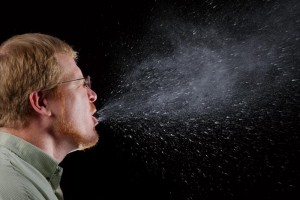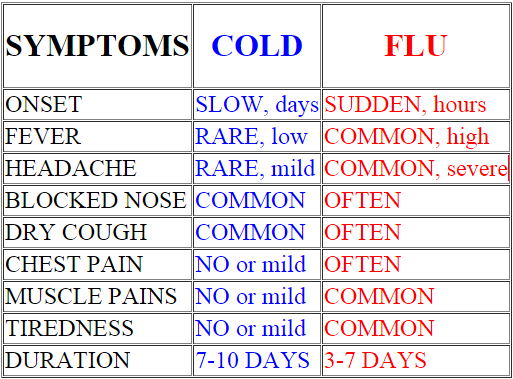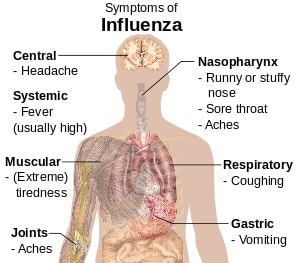How to tell the difference between a cold and the flu?
Both a cold and the flu are the respiratory viral infections that most commonly occur during the colder period of the year.
Chart 1. Cold vs flu symptoms
A cold is usually a mild disease limited to the nose and throat, but influenza affects your whole body and often puts you into bed. A severe cold can be hard to distinguish from the mild flu, especially in children. Only laboratory tests can reliably distinguish between a cold and the flu.
Picture 1. Flu symptoms diagram
(source: Wikipedia, Creative Commons license)
Medical Terms, Etymology and Definitions
A cold
A cold or common cold is medically called acute nasopharyngitis [acute = sudden; naso = nose; pharynx = throat; -itis denotes inflammation] (36). So, a cold is a respiratory viral infection that causes inflammation of the nose and throat.
The flu
The term flu is short for influenza, which is an Italian word that originates from the Latin word influentia, which means influence. In medieval times, they used the word influence for the epidemic. Some people also believed that the stars have the influence on the disease (19).
Seasonal or epidemic influenza that appears every year and can affect many people in various regions is a respiratory infection caused by various influenza viruses that affect the nose, throat, lungs, muscles and joints (47).
Other types of flu: 2009 H1N1 pandemic influenza (once called “swine flu”), bird flu (avian influenza).
Cold vs Flu Chart
Chart 2. Cold vs Flu: causes, spread, contagious period, symptoms, signs, prevention, treatment.
A cold |
The flu |
|
| Full name | Common cold | Seasonal influenza (in some European languages: grippe, gripe, gripa) |
| Scientific name, medical term | Acute nasopharyngitis (36) | Epidemic influenza (1) |
| Cause | >200 viruses: rhinovirus, coronavirus, adenovirus, coxsackievirus, echovirus, influenza A and B virus, metapneumovirus, parainfluenza virus, respiratory syncytial virus (RSV), enterovirus (41,68) | Influenza virus type A, subtype H3N2, is the most common (1).Influenza virus type B is usually milder than type A, and type C is milder than type B (13). |
| Season, Flu Map | Autumn, winter and spring, but also in summer (69-p.171) | On the Northern Hemisphere (US, Canada, China, Russia, Europe) the flu season peaks at January/February, but can last from October to March or even May (7).The expected peak in Australia: June to AugustThe flu map |
Source of infection and the way of spreading Picture 2. Sneezing Picture 2. Sneezing(CDC, CC license)  Picture 3. Shaking hands (Wikimedia, CC license)
|
Source: infected humans, especially children (41)Spread (11,41,50,70):
|
Source: infected humans (1), rarely infected ferrets (14)Spread (1,17,50):
The flu is probably NOT spread by sexual intercourse itself. |
| Risk factors |
|
Age <5 or >65, chronic disease (diabetes, asthma, chronic bronchitis, kidney, heart or liver disease, cancer, impaired mobility, sickle cell anemia), impaired immunity (HIV/AIDS, steroids, aspirin), pregnancy, increased exposure (health workers) (1,8), smoking (53) |
| Incubation period (from exposure to onset of symptoms) | 10 hours-5 days, usually 1-3 days (11,41) | 1-4 days; in average 2 days (1) |
| Contagious period | From 2 days before the onset to the end of symptoms but less likely after 7th day of symptoms; increases with symptom severity (42,43) |
|
| Affected body part | Nose, throat (36) | Nose, throat, lungs, muscles, joints (47) |
| SYMPTOMS | References (41) | References (1) |
| – Onset | Slow, over few days | Usually quick, in few hours |
| – Stuffy, runny nose, sneezing | Common | Sometimes |
| – Dry cough | Common | Sometimes |
| – Sore throat | Common, mild | Sometimes |
| – Headache | Rarely, mild | Common, can be severe |
| – Fever | Rarely; low; more common in children | Usually; high (often above 39 °C), lasts 3-4 days; in small children may be absent |
| – Cold sores | Possible | Possible |
| – Sweating | Rare | Common |
| – Chills | Less likely | Often |
| – Muscle pains | Less likely | Common |
| – Tiredness | No or mild | Common, can last 2-3 weeks |
| – Exhaustion | Not likely | Common |
| – Vomiting, diarrhea | Not likely | Sometimes, mainly in children |
| Duration of symptoms | 2-14 days (average: 7-10 days) (41) | Main symptoms resolve in 3-7 days; malaise and cough may persist >2 weeks (1,10) |
| Signs | Swollen nasal mucosa, red throat, possibly enlarged lymph nodes in the neck (11) | Swollen nasal mucosa, red throat |
| Complications, prognosis |
|
Complications, which may be deadly, are more likely in young children, people after 65, those with chronic diseases and pregnant women.
|
| Diagnosis, tests | Usually, no tests are needed.Sinus endoscopy or CT or MRI, when complicated sinusitis is suspected (46) | A throat or nasal swab or nasal aspirate within 4 days of symptoms onset followed by:
|
| Prevention |
NOT proven effective: alcohol sanitizers (gels), Andrographis, Astragalus, Chinese herbal medicines, Echinacea, elderberry, garlic, green tea, guided imagery, honey, hydrotherapy, nasal irrigation (neti pot) (44), North American ginseng, stress management, vitamins C, D, E (11,50,68). |
NOT proven effective: alcohol sanitizers for hands, Chinese herbal medicines, Echinacea, elderberry, green tea, nasal irrigation (neti pot) (44), N-acetylcysteine, North American ginseng, Oscillococcinum, pomegranate extract, vitamin C or D (11,50). |
| Vaccines | No vaccines have been developed because many different types of viruses can cause a cold. |
|
| Treatment |
NOTE: Antibiotics are not effective and should not be used to treat common cold. References: (11) |
NOTE: Antibiotics are not effective and should not be used to treat flu. References: (3,9,52)
|
| Immunity | Having a cold does not protect you from getting a cold again soon (41) | Having the flu does not necessary protect you from getting the flu again in the same flu season, because you can get infected by another strain of the virus that you are not immune to (17). |
Flu Vaccines Types and Side Effects
Flu vaccines contain killed or weakened (attenuated) influenza viruses. Vaccination triggers the production of antibodies against influenza viruses in your body (73).
All below vaccines, if you get them once a year, should protect you against flu for the whole. Despite vaccination, there is a small chance you catch a flu infection caused by a flu virus strain not included in the vaccine.
Trivalent flu vaccine protects against 3 types of influenza: seasonal influenza A (H3N2) and one type of influenza B, and 2009 pandemic influenza (H1N1), but not against variant seasonal influenza (H3N2v) and bird (avian) flu (73). Quadrivalent flu vaccine additionally protects against another type of influenza B virus (78).
- Regular seasonal flu shot (trivalent or quadrivalent) is an intramuscular injection with a needle, usually in the upper arm; it contains killed viruses. It is intended for anyone older than 6 months, including pregnant women; especially for health workers, persons older than 65 and those with chronic diseases (asthma, heart disease, diabetes), residents of nursing homes, contacts with infants younger than 6 months (5,73).
- A recombinant flu shot (trivalent) is an intramuscular injection for individuals 18 years or older who are allergic to eggs; it is made without using eggs (77).
- A high-dose vaccine (trivalent) is an intramuscular injection that contains 4 times the amount of antigen as the regular vaccine and is, according to CDC.gov, about 25% more effective; it is intended for people after age 65 (74,79).
- An intradermal vaccine (trivalent) is for injection into the skin, using smaller needle; it is intended for individuals from age 18 to 64 (75). It is about as effective as intramuscular vaccine (34,75).
- The nasal spray flu vaccine or LAIV – Live Attenuated Influenza Vaccine (quadrivalent) contains live weakened influenza viruses (76). It is intended for healthy, nonpregnant persons age 2-49, once a year, for some children twice a year. In adults, it is as effective (65,66,76), and in children (6 months to 6 years), it is, according to 2 studies, 53-55% more effective than intramuscular vaccine (39,61).
Eventual antiviral drugs must be stopped at least 48 hours before vaccination. Vaccine needs 2 weeks to become fully protective.
Vaccine Effectiveness
Results of studies about flu vaccines effectiveness:
- According to CDC.gov “flu vaccine reduces a person’s risk of developing flu illness that results in a visit to the doctor’s office or urgent care provider by 60%” (81). The effectiveness of flu vaccine for the season 2014/2015 as estimated in January 2015 by CDC.gov was only 23%, though (10).
- According to one 2012 systematic review of studies (1967-2011), in individuals age 18-65, a trivalent vaccine was effective in 59% cases, and in children age 8-17, nasal spray (LAIV vaccine) was 83% effective in prevention of the flu (51).
- In one 2013 Danish study, flu vaccination in a 2012/2013 season was effective against influenza A in 11%, and against influenza B in 69% cases (80).
- In one study in the United States in 2007/2008 season, from 629 vaccinated participants, 177 (28%) got influenza A (H3N2) within the same season; the mean interval between vaccination and illness was 101 days (82).
Possible Vaccine Side Effects
- Flu vaccines do not cause flu.
- Intramuscular, but more likely high dose and intradermal vaccines, can cause soreness, swelling, redness and itching at the injection site, headache, muscle ache or tiredness, which can last 3-7 days.
- Nasal spray. Possible side effects in children: runny nose, headache, wheezing, vomiting, muscle aches, fever; in adults: a runny nose, headache, sore throat and cough.
- Life-threatening allergic reactions (breathing problems, hoarseness or wheezing, hives, paleness, weakness, a fast heartbeat, dizziness), within few minutes or hours after the shot, are very rare, more likely in persons with a severe allergy to eggs, because the viruses used in most influenza vaccines are grown in hens’ eggs.
- Guillain-Barre syndrome, an acute neurological disorder with weak muscles, after the flu shot is very rare.
- References (73,74,75,76)
Who should NOT get vaccinated: infants <6 mo, anyone with acute illness with fever, allergy to chicken eggs or severe reaction or Guillain-Barre syndrome to a flu vaccine in the past, who is not at high risk of severe illness from the flu (75).
Other Types of Flu
Variant Influenza Virus H3N2v
Influenza viruses that are normally found in pigs are called variant viruses when they infect people. A specific virus influenza A (H3N2v) was first detected in 2011 in the United States, mainly in children. Most infected people were in contact with pigs, which spread the infection by sneezing and coughing. Spread of the virus H3N2v from human to human is not proven (16). You cannot catch this virus by eating properly cooked pork. Severity of symptoms is like in seasonal influenza (H3Nv). As of July 2015, vaccine against H3N2v is not yet available. This type influenza can be treated with the same medications than usual seasonal influenza, that is with oseltamivir and zanamivir (31).
2009 H1N1 Pandemic
The 2009 H1N1 influenza pandemic was once called “swine flu,” since researchers believed that it has spread from pigs to humans, which probably has occurred initially, but in most cases it spreads from human to human (20). The symptoms of H1N1 influenza resemble those of seasonal flu, but tend to be more severe and more commonly causes death; mortality rates are 1-4% (21,28).
Diagnosis. H1N1 influenza and seasonal influenza cannot be distinguished by symptoms but only by laboratory tests of the secretions from the nose and throat (nasal or throat swabs) (21,29):
- The Human Influenza Virus Real-Time RT-PCR Detection and Characterization Panel (rRT-PCR Flu Panel) can distinguish between H1N1 virus and all other influenza A subtypes that cause seasonal, avian influenza, Influenza A and B viruses, Influenza A subtypes: virus influenza A H3N2 (seasonal influenza), virus influenza A H1N1 (2009 pandemic influenza) and virus influenza A H5N1 and AH7N9 (avian influenza) (30).
Treatment includes antiviral medications oseltamivir and zanamivir within 48 hours of symptoms onset (57).
Yearly trivalent vaccine (the same as for seasonal flu) includes protection against 2009 H1N1 virus (4,15).
What is the swine flu?
Current meaning (as of 2015) of “swine flu” or “swine influenza,” according to the Centers of Disease Control and Prevention (CDC) in the U.S. (56):
- Infection in pigs by any type of influenza virus
- Infection in humans by the variant influenza virus H3N2v, which spreads from pigs to human; currently only in the United States.
The 2009 H1N1 influenza pandemic was initially called the swine flu because it has probably spread from pigs to humans on the beginning, but now it mainly spreads from human to human, so the CDC does not use the term swine flu for this type of influenza any more; however, many other institutions and medical websites still do.
The Bird Flu (Avian Influenza)
- So far, avian influenza A (H5N1) in humans, was reported from South Asia, Indonesia, Middle East and Africa (data from WHO from 2003 to June 2013) (27).
- The outbreak of avian influenza A (H7N9) in humans was reported in April 2013 and was, to date (July 10 2013), limited to China (26).
The bird flu or avian influenza is caused by Avian influenza A (H5N1) (22,24) or influenza A (H7N9) virus (26), which can spread from birds to humans, but less commonly from human to human (22). Humans are most likely infected during close contact with live or dead domestic poultry (chickens, turkeys, ducks, geese), their droppings and infected water, equipment, shoes and clothes, but not with properly cooked meat or eggs (22,24). Symptoms of the bird flu resemble those of the seasonal flu, but the bird flu causes much more deaths than seasonal flu; mortality rate can be as high as 60% (22,23). Difficulty breathing, hoarseness and blood in the spit are common.
Diagnosis of the bird flu is confirmed when the virus influenza H5N1 or H7N9 is found in samples of secretions from the nose or throat (nasal or throat swab) within the first few days after symptoms onset; the test used is rRT-PCR Flu Panel (25,55).
Treatment with the antiviral drug oseltamivir or zanamivir within the first two days of symptoms onset, if possible, can reduce the severity of symptoms (22,25).
“Stomach Flu”
The terms stomach flu or gastric, tummy or intestinal flu are often used for an infection of the stomach and intestine (gastroenteritis) caused by rotavirus or other microbes, which can cause both stomach symptoms (vomiting, diarrhea) and flu-like symptoms (fever, stuffy nose) (48). The stomach flu is not related to the seasonal flu and is not caused by the influenza virus.
Chart 3. Diseases with Flu-Like Symptoms |
|
Diseases |
Symptoms |
| Allergic rhinitis | Watery discharge, itchy nose, throat and eyes |
| Sinusitis | Pain in the front of the head or on either side of the nose, stuffy nose, thick nasal discharge |
| Bacterial pharyngitis (e.g. “strep throat”) | Sore and red throat, cough, hoarseness, high fever, swollen lymph nodes behind the ears, neck pain |
| Asthma | Attacks of difficult breathing, wheezing |
| Bronchitis | Coughing up yellow/green mucus, difficulty breathing, bluish discoloration of the face and hands |
| Viral or atypical pneumonia | Low-grade fever, malaise, tiredness, dry cough, chest pain |
| Bacterial pneumonia | High temperature (>104 °F or 40°C), shortness of breath |
| Lyme disease or borreliosis | red rash that expands in a bulls eye pattern, fever, chills, fatigue |
| Tuberculosis | coughing up thick mucus or blood, low-grade fever, chest pain, malaise |
| Viral meningitis | fever, headache, stiff neck, vomiting, rash that does not fade away upon pressing, photophobia, drowsiness |
| HIV/AIDS | |
| Cancer | Pain, fatigue |
| Leukemia | Low-grade fever, fatigue |
| Chronic fatigue syndrome (CFS) | Fatigue, vague muscle aches |
| Fibromyalgia | Fatigue, muscle and joint aches |
| Toxic shock syndrome (TSS) caused by a staph or strep infection in women who use tampons | Sudden high fever, low blood pressure, vomiting, rash on palms and soles |
| Drugs: clopidogrel (blood thinner), efalizumab (for psoriasis), fibrates and statins (to lower cholesterol), lamotrigine (antiepileptic), leflunomide (for rheumatoid arthritis), medroxyprogesterone, mesalazine and sulfasalazine (for inflammatory bowel disease – IBD), rifampin (for tuberculosis), verapamil (for the heart), zolpidem (for insomnia) (33,62) | Possible low-grade temperature and rash |
Chart 3 reference: (59)
Chart 4. Diseases With Bad Flu-Like Symptoms in Children |
|
| Bronchiolitis | In infants, small children: stuffy nose, mild fever, mild cough, rapid, shallow breathing |
| Croup | Runny nose, fever, hoarseness and barking cough |
| Whooping cough (pertusis), a bacterial infection in small children | Violent cough in small children |
| Childhood infections with rashes: measles, chicken pox, rubella, scarlet fever, hand, foot and mouth disease, fifth disease (erythema infectiosum) | Rash, fever, sometimes headache or runny nose |
| Infectious mononucleosis or “mono” | Swollen glands in the neck, armpits and groin, low-grade fever |
Influenza-Like Illness (ILI)
Influenza-like illnesses (ILIs) are defined as diseases with flu-like symptoms (fever >100 °F or 37.8 °C, cough and/or sore throat) that are not caused by influenza viruses (negative flu test) and their cause remains undetermined in further diagnostic procedures (58).
FREQUENTLY ASKED QUESTIONS
1. Does cold weather increase the risk of common cold and the flu?
According to one hypothesis, you more likely catch a viral infection of the upper respiratory tract in colder months because your nose is colder and thus more susceptible to infections (38). Also, viruses that cause cold and flu survive more readily in lower humidity during the colder months (45,68).
Some researchers believe that exposure to low temperatures does not increase your chance to catch a common cold or flu (11,68). In one study, students who had their feet chilled in cold water for 20 minutes got a cold in the next 5 days in 50% more cases than students whose feet were not chilled (41).
There seems to be no clear proof that dampness and mold in houses increase your risk of getting common cold.
Exercise, diet or enlarged tonsils have also not been proven as a risk factor for a cold or the flu (68).
2. Can you catch the flu from dogs and other animals?
- Spread of seasonal influenza from ferrets to humans was reported in few cases (14).
- Pigs can spread variant influenza virus (H3N2v) to humans, so far only in the United States (31). It is not clear if seasonal influenza virus H3N2 and influenza 2009 H1N1 virus are regularly transmitted from pigs to humans.
- Humans can catch avian influenza H5N3 and H7N9 from birds, mainly poultry (chickens, ducks, geese, turkeys).
- Transmission of canine influenza from dogs to humans was not reported so far (54).
3. What are early and late symptoms and signs of a cold and the flu?
Early symptoms:
- A cold: feeling unwell, sneezing, scratchy throat, clear mucus from the nose (41)
- The flu: sudden fever and headache, which can develop from complete health within an hour (1)
Late symptoms:
- A cold: nose irritation (rhinitis), sneezing, blocked nose with a thick, yellow or green discharge, sore or itchy throat, cough (usually dry), watery and itchy eyes, mild tiredness and, rarely, mild headache or low-grade fever (41,68)
- The flu: high fever, chills, headache, muscle aches (myalgia), runny nose, tiredness, exhaustion, loss of appetite, vomiting and diarrhea (mainly in small children) (1).
- Severe flu (with a severe lung inflammation): fast or difficult breathing, bluish lips or fingers, symptoms of dehydration (thirst, dry mouth and lips, paleness, dizziness), confusion, impaired consciousness.
4. Can rash develop in common cold or flu?
- Cold sores–reactivation of an old Herpes virus infection–on the lips are common both in cold and flu (40).
- Rash usually does NOT occur in common cold and seasonal influenza, but can occur in 2009 H1N1 influenza (pandemic flu) (60). Rash accompanied with flu-like symptoms may be a symptom of another disease, such as meningitis, measles, chickenpox, rubella or infectious mononucleosis.
5. Is a common cold in kids different than in adults?
- Children tend to get a cold more often than adults (41). Children with a common cold often have a fever, while adults rarely have it (41).
- Aspirin should not be used to treat a cold in infants, children and adolescents to avoid the risk of Reye’s syndrome (a severe liver damage) (12).
- Small children under two years with a common cold should not get any nonprescription medications since their effect in this age is questionable–in the case of severe symptoms, they should be treated appropriately by a doctor (18).
6. Does influenza in babies, toddlers, children and adults differ?
- Infants with influenza often do not have a fever.
- Children with the flu more often have nausea and vomiting than adults (1).
7. Can a cold turn into the flu?
Sometimes, influenza viruses cause only a mild infection resembling a common cold. During its course, the infection can become worse and develop into a full blown flu. Other viruses that usually cause a common cold, such as rhinovirus, do not cause influenza, so, in most cases, cold does not turn into the flu.
8. Advice about the diet during a common cold or influenza
The general rule about the diet during uncomplicated infections in otherwise healthy people: eat what agrees with you, do not eat if you do not feel like eating but drink enough fluid to prevent dehydration. Eat light foods that do not irritate your stomach.
- Examples of appropriate drinks: plain water, mineral water, herbal tea, sport drinks, chicken soup. Juices, soda and other sweet drinks may aggravate nausea. Small children with repeated vomiting or diarrhea should receive oral rehydration solutions (ORS).
- Examples of appropriate foods: bread, toast, morning cereals, biscuits, rice, boiled potatoes and other foods that do not trigger nausea. Children can eat what they usually do. According to many pediatricians, children with diarrhea do not need to stick with a BRAT diet (Bananas, Rice, Applesauce, Toast) but can eat other foods as well. It is good to include some dietary fiber, for example, whole grain bread, to prevent constipation; fruits, legumes and oats may not be convenient, because they may cause abdominal bloating.
- References
- Clinical Signs and Symptoms of Influenza Centers for Disease Control and Prevention
- Influenza Symptoms and the Role of Laboratory Diagnostics Centers for Disease Control and Prevention
- Influenza Antiviral Medications: Summary for Clinicians Centers for Disease Control and Prevention
- Key Facts About Seasonal Flu Vaccine Centers for Disease Control and Prevention
- Treating Influenza Centers for Disease Control and Prevention
- CDC Says “Take 3” Actions To Fight The Flu Centers for Disease Control and Prevention
- Seasonal Flu Flu.gov
- People at High Risk of Developing Flu–Related Complications Centers for Disease Control and Prevention
- Lifestyle and Home Remedies Mayo Clinic
- CDC Presents Updated Estimates of Flu Vaccine Effectiveness for the 2014-2015 Season Centers of Disease Control and Prevention
- The common cold Department of Public Health and Services Montana
- Reye Syndrome KidsHealth
- Types of Flu WebMD
- Rest Easy. When It Comes to Swine Flu, Your Pet Is Safe U.S.News
- Types of Influenza Viruses Centers for Disease Control and Prevention
- Key Facts about Human Infections with Variant Viruses (Swine Origin Influenza Viruses in Humans) Centers for Disease Control and Prevention
- 10 Misconceptions About Cold and Flu ABCNews
- An Important FDA Reminder for Parents: Do Not Give Infants Cough and Cold Products Designed for Older Children US Food and Drug Administration
- Influenza Etymonline
- Swine Flu FAQ WebMD
- Swine Flu FAQ WebMD
- Avian Influenza World Health Organization
- H5N1 research issues World Health Organization
- Bird flu (avian flu) NHS.uk
- Avian Influenza A Virus Infections in Humans Centers for Disease Control and Prevention
- Avian Influenza A (H7N9) Virus Centers for Disease Control and Prevention
- Cumulative number of confirmed human cases for avian influenza A(H5N1) reported to WHO, 2003-2013 World Health Organization
- H1N1 Influenza (Swine Flu) Emedicine
- Guidance for Clinicians on the Use of Rapid Influenza Diagnostic Tests Centers for Disease Control and Prevention
- H1N1 Influenza (Swine Flu) Workup Emedicine
- H3N2v and You Centers for Disease Control and Prevention
- Bin-Reza F et al, 2012, The use of masks and respirators to prevent transmission of influenza: a systematic review of the scientific evidence PubMed
- Medications or Substances causing Flu-like symptoms Rightdiagnosis.com
- Young F et al, 2011, A systematic review of intradermal influenza vaccines PubMed Health
- Use of antivirals Centers for Disease Control and Prevention
- WHO Model Prescribing Information: Drugs used in Bacterial Infections World Health Organization
- Cohen S et al, 1993, Smoking, Alcohol Consumption, and Susceptibility to the Common Cold PubMed Central
- Eccles R, 2002, An explanation for the seasonality of acute upper respiratory tract viral infections PubMed
- Askhenazi S et al, 2006, Superior relative efficacy of live attenuated influenza vaccine compared with inactivated influenza vaccine in young children with recurrent respiratory tract infections PubMed
- What are cold sores Know Your Teeth
- General Common Cold Information Cardiff University
- Common Cold MedlinePlus
- Common cold contagious period Emedtv.com
- Kassel JC et al, 2010, Saline nasal irrigation for acute upper respiratory tract infections PubMed
- Polozov IV, 2008, Progressive ordering with decreasing temperature of the phospholipids of influenza virus Nature Chemical Biology
- Sinusitis Diagnosis Mayo Clinic
- Flu Definition Mayo Clinic
- Stomach Flu KidsHealth.org
- Influenza Tests Labtestsonline.org
- Common Cold, and Complementary Health Approaches National Center for Complementary and Integrative Health
- Osterholm MT et al, 2012, Efficacy and effectiveness of influenza vaccines: a systematic review and meta-analysis PubMed
- What Everyone Should Know and Do Snort. Sniffle. Sneeze. No Antibiotics Please! Centers for Disease Control and Prevention
- You, smoking and the flu Health.ny.gov
- Key Facts about Canine Influenza (Dog Flu) Centers for Disease Control and Prevention
- Diagnostics for Detecting H7N9 Using rRT-PCR Centers for Disease Control and Prevention
- Information on Swine Influenza/Variant Influenza Viruses Centers for Disease Control and Prevention
- H1N1 Influenza (Swine Flu) Medication Emedicine
- Influenza-Like Illness Case Definition American College Health Association
- Flu-like Symptoms: Causes Healthgrades
- Rosenberg M et al, 2009, Rash associated with pandemic (H1N1) influenza Canadian Medical Association Journal
- Belshe RB et al, 2007, Live Attenuated versus Inactivated Influenza Vaccine in Infants and Young Children The New England Journal of Medicine
- Sulfasalazine side effects Drugs.com
- Godoy P et al, 2012, Effectiveness of hand hygiene and provision of information in preventing influenza cases requiring hospitalization PubMed
- Wong VW et al, 2014, Hand hygiene and risk of influenza virus infections in the community: a systematic review and meta-analysis PubMed
- Jefferson T et al, 2012, Vaccines for preventing influenza in healthy children Cochrane
- Demicheli V et al, 2014, Vaccines to prevent influenza in healthy adults Cochrane
- Jefferson T et al, 2014, Regulatory information on trials of oseltamivir (Tamiflu) and zanamivir (Relenza) for influenza in adults and children Cochrane
- About the common cold Villanova University
- Bernstein D, Shelov SP, 2012, Viruses that cause upper and lower respiratory tract infections Pediatrics for Medical Students, 3rd Edition
- Arrol B, 2008, Common cold PubMed Central
- Science M et al, 2012, Zinc for the treatment of the common cold: a systematic review and meta-analysis of randomized controlled trials PubMed Central
- King S et al, 2014, Effectiveness of probiotics on the duration of illness in healthy children and adults who develop common acute respiratory infectious conditions: a systematic review and meta-analysis PubMed Central
- Seasonal Flu Shot Centers for Disease Control and Prevention
- Fluzone High-Dose Seasonal Influenza Vaccine Centers for Disease Control and Prevention
- Intradermal Influenza (Flu) Vaccination Centers for Disease Control and Prevention
- Live Attenuated Influenza Vaccine [LAIV] (The Nasal Spray Flu Vaccine) Centers for Disease Control and Prevention
- Flublok Seasonal Influenza (Flu) Vaccine Centers for Disease Control and Prevention
- Quadrivalent Influenza Vaccine Centers for Disease Control and Prevention
- Fluzone High-Dose Vaccine US Food and Drug Administration
- Bragstad K et al, 2013, LOW VACCINE EFFECTIVENESS AGAINST INFLUENZA A(H3N2) VIRUS AMONG ELDERLY PEOPLE IN DENMARK IN 2012/13 – A RAPID EPIDEMIOLOGICAL AND VIROLOGICAL ASSESSMENT EuroSurveillance
- Vaccine Effectiveness – How Well Does the Flu Vaccine Work? Centers for Disease Control and Prevention
- Belongia EA et al, 2015 Waning vaccine protection against influenza A (H3N2) illness in children and older adults during a single season ScienceDirect





Pingback: Difference between common cold and flu? – DigMedicine